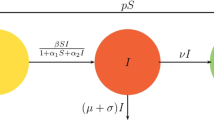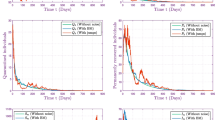Abstract
A susceptible–infected–susceptible almost periodic reaction–diffusion epidemic model is studied by means of establishing the theories and properties of the basic reproduction ratio \({R_{0}}\). Particularly, the asymptotic behaviors of \({R_{0}}\) with respect to the diffusion rate \({D_{I}}\) of the infected individuals are obtained. Furthermore, the uniform persistence, extinction and global attractivity are presented in terms of \({R_{0}}\). Our results indicate that the interaction of spatial heterogeneity and temporal almost periodicity tends to enhance the persistence of the disease.
Similar content being viewed by others
References
Allen L.J.S., Bolker B.M., Lou Y., Nevai A.L.: Asymptotic profiles of the steady states for an SIS epidemic disease patch model. SIAM J. Appl. Math. 67, 1283–1309 (2007)
Allen L.J.S., Bolker B.M., Lou Y., Nevai A.L.: Asymptotic profiles of the steady states for an SIS epidemic reaction–diffusion model. Discrete Contin. Dyn. Syst. A 21, 1–20 (2008)
Altizer S., Dobson A., Hosseini P., Hudson P., Pascual M., Rohani P.: Seasonality and the dynamics of infectious diseases. Ecol. Lett. 9, 467–484 (2006)
Bacaër N., Guernaoui S.: The epidemic threshold of vector-borne diseases with seasonality. J. Math. Biol. 53, 421–436 (2006)
Caraco T., Glavanakov S., Chen G., Flaherty J.E., Ohsumi T.K., Szymanski B.K.: Stage structured infection transmission and a spatial epidemic: a model for Lyme disease. Am. Nat. 160, 348–359 (2002)
Corduneanu C.: Almost Periodic Functions. Chelsea Publishing Company, New York, NY (1989)
Daners, D., Koch Medina, P.: Abstract Evolution Equations, Periodic Problems and Applications (Pitman Research Notes in Mathematics Series vol. 279). Harlow, Longman Scientific & Technical (1992)
Diekmann O., Heesterbeek J.A.P., Metz J.A.J.: On the definition and the computation of the basic reproduction ratio \({R_{0}}\) in the models for infectious disease in heterogeneous populations. J. Math. Biol. 28, 365–382 (1990)
Fink, A.M.: Almost Periodic Differential Equations, Lecture Notes in Mathematics, Springer, Berlin (1974)
Gilbarg I.D., Trudinger N.S.: Elliptic Partial Differential Equations of Second Order, 2nd ed. Springer, Berlin (1983)
Hale, J.K.: Asymptotic Behavior of Dissipative Systems, Mathematical Surveys and Monographs, vol. 25. American Mathematical Society, Providence, RI (1988)
Henry, D.: Geometric Theory of Semilinear Parabolic Equations, Lecture Notes in Mathematics 840. Springer, Berlin (1981)
Hess, P.: Periodic-Parabolic Boundary Value Problems and Positivity, Pitman Research Notes in Mathematics, Series 247. Longman Scientific and Technical (1991)
Huang W., Han M., Liu K.: Dynamics of an SIS reaction–diffusion epidemic model for disease transmission. Math. Biosci. Eng. 7, 51–66 (2010)
Hutson V., Mischaikow K., Polácik P.: The evolution of dispersal rates in heterogeneous time-periodic environment. J. Math. Biol. 43, 501–533 (2001)
Hutson V., Shen W., Vickers G.T.: Estimates for the principal spectrum point for certain time-dependent parabolic operators. Proc. Am. Math. Soc. 129, 1669–1679 (2000)
Lewis M., Renclawowicz J., van den Driessche P.: Traveling waves and spread rates for a West Nile virus model. Bull. Math. Biol. 68, 3–23 (2006)
Lieberman G.M.: Second Order Parabolic Differential Equations. World Scientific, River Edge, NJ (1996)
Lou Y., Zhao X.-Q.: A reaction–diffusion malaria model with incubation period in the vector population. J. Math. Biol. 62, 543–568 (2011)
Murray J.D., Stanley E.A., Brown D.L.: On the spatial spread of rabies among foxes. Proc. R. Soc. Lond. Ser. B 229, 111–150 (1986)
Ou C., Wu J.: Spatial spread of rabies revisited: Influence of age-dependent diffusion on nonlinear dynamics. SIAM J. Appl. Math. 67, 138–163 (2006)
Pang P.Y.H., Wang M.: Strategy and stationary pattern in a three-species predator-prey model. J. Diff. Equ. 200, 245–273 (2004)
Peng R.: Asymptotic profile of the positive steady state for an SIS epidemic reaction–diffusion model: I. J. Diff. Equ. 247, 1096–1119 (2009)
Peng R., Liu S.: Global stability of the steady states of an SIS epidemic reaction–diffusion model. Nonlinear Anal. TMA 71, 239–247 (2009)
Peng R., Zhao X.-Q.: A reaction–diffusion SIS epidemic model in a time-periodic environment. Nonlinearity 25, 1451–1471 (2012)
Protter M.H., Weinberger H.F.: Maximum Principles in Differential Equations. Springer, Berlin (1984)
Sacker R., Sell G.: A spectral theory for linear differential systems. J. Diff. Equ. 27, 320–358 (1978)
Sell G.: Topological Dynamics and Ordinary Differential Equations. Van Nostrand Reinhold, London (1971)
Shen W., Yi Y.: Almost automorphic and almost periodic dynamics in skew-product semiflows. Mem. Am. Math. Soc. 647, 136 (1998)
Thieme H.R.: Spectral bound and reproduction number for infinite-dimensional population structure and time heterogeneity. SIAM J. Appl. Math. 70, 188–211 (2009)
van den Driessche, P., Watmough, J.: Reproduction numbers and sub-threshold endemic equilibria for compartmental models of disease transmission. Math. Biosci. 180, 29–48 (2002)
Wang B.-G., Zhao X.-Q.: Basic reproduction ratios for almost periodic compartmental epidemic models. J. Dyn. Diff. Equ. 25, 535–562 (2013)
Wang W., Zhao X.-Q.: A nonlocal and time-delayed reaction–diffusion model of dengue transmission. SIAM J. Appl. Math. 71, 147–168 (2011)
Wang W., Zhao X.-Q.: Threshold dynamics for compartmental epidemic models in periodic environments. J. Dyn. Diff. Equ. 20, 699–717 (2008)
Wang Y., Zhao X.-Q.: Global convergence in monotone and uniformly stable recurrent skew-product semiflows. Infinite dimensional dynamical systems. Fields Inst. Commun. 64, 391–406 (2013)
Zhao X.-Q.: Persistence in almost periodic predator-prey reaction–diffusion systems. Fields Inst. Commun. 36, 259–268 (2003)
Zhao X.-Q.: Global attractivity in monotone and subhomogeneous almost periodic systems. J. Diff. Equ. 187, 494–509 (2003)
Zhao X.-Q.: Dynamical Systems in Population Biology. Springer, New York (2003)
Zhao X.-Q.: Global dynamics of a reaction and diffusion model for Lyme disease. J. Math. Biol. 65, 787–808 (2012)
Author information
Authors and Affiliations
Corresponding author
Rights and permissions
About this article
Cite this article
Wang, BG., Li, WT. & Wang, ZC. A reaction–diffusion SIS epidemic model in an almost periodic environment. Z. Angew. Math. Phys. 66, 3085–3108 (2015). https://doi.org/10.1007/s00033-015-0585-z
Received:
Revised:
Published:
Issue Date:
DOI: https://doi.org/10.1007/s00033-015-0585-z




